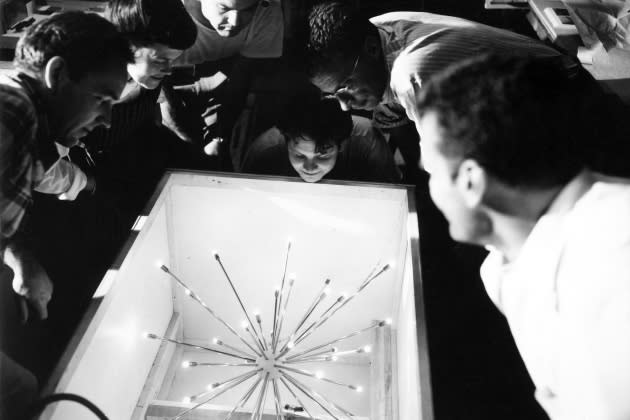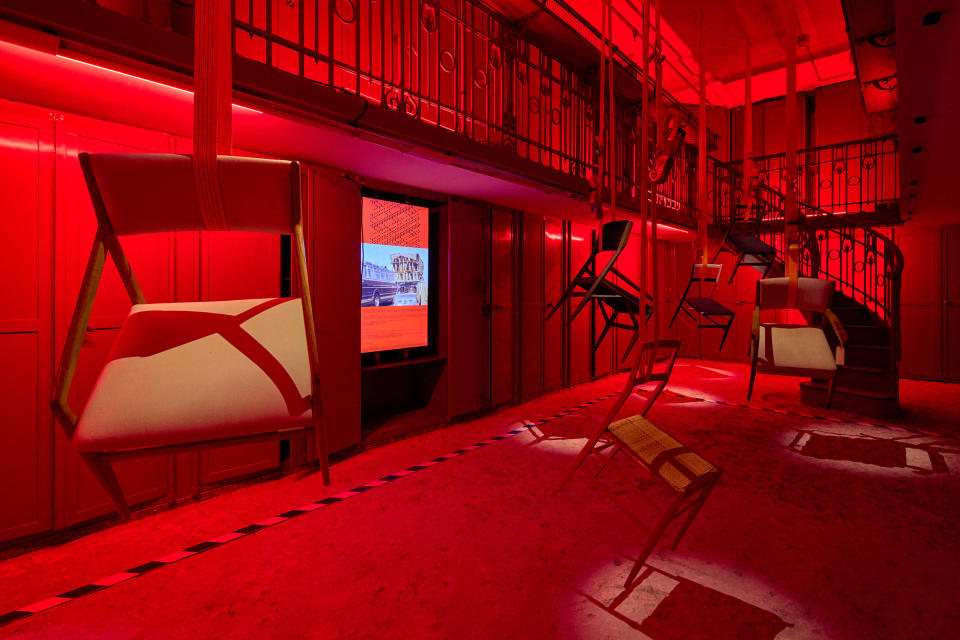Patricia Urquiola Opens Cassina’s Echoes Exhibit

MILAN — Induction into the Cassina iMaestri realm of design masters is an honor. There’s one catch: you can’t be living.
Bygone greats and 20th-century masters like Charlotte Perriand, Le Corbusier, Pierre Jeanneret and Ico Parisi have all had their work crystallized in time by Cassina’s iMaestri universe, which was first presented to the public in 1973 with icons by Gerrit T. Rietveld and Charles Rennie Mackintosh. Since then the upscale furniture company has used the project to fuel the research behind some of the most significant pieces of furniture by leading figures of the Modern Movement.
More from WWD
At Milan’s Design Week, the brand unfurled “Echoes, 50 Years of iMaestri,” curated by its art director Patricia Urquiola with Milan-based curator and design adviser Federica Sala. The exhibit will be open to the public at Palazzo Broggi until Friday.
A celebration of the past with a new vision for the future, the exhibit is also a physical preview of the upcoming book “Echoes,” overseen by contemporary design producer Ivan Mietton and published by Rizzoli, to be released in fall 2023.

Inside a cavernous basement, an exuberant Urquiola took journalists on a tour in three languages: Italian, Spanish and English.
“Mira!” she exclaimed, telling journalists to look up at floral Liberty-era elements dispersed to enhance the dreamlike theme. In a hidden compartment under a staircase, she pointed to some prototypes of the Midway Z, a chair first designed by Frank Lloyd Wright in 1914. “We don’t have the rights to these, but that’s OK. We need to just embrace it,” she said, adding she “nearly had a heart attack” when she first saw the Palazzo Broggi basement, the stage of the exhibition that unfurled in a Surrealist dream, where visionary works are hidden in compartments like secret corners of the subconscious.
“The vault is a metaphor for the legacy of Cassina,” she pointed out.
Awash in red lights, the soundtrack unfolds in random exerpts of old speeches, chilling echoes and radio static. At a certain point, the lights flicker and then go out.
“I love this, you never know what’s happening next,” Urquiola enthused before guests, who perhaps wondered if a fuse had been blown.
This year the Cassina iMaestri Collection welcomed new names Vico Magistretti, Gio Ponti, Carlo Scarpa and Charles and Ray Eames into this exclusive universe. The Eameses work also served as the genesis of the Cassina Lighting Collection, which was inspired by the duo’s innovative creations.
A prototype of Galaxy, an aluminum pendant lamp designed by the Eameses and which was first shown at Detroit’s “An Exhibition for Modern Living” in 1949, was developed especially for the exhibition — this time showcased with photos and letters explaining how it was made out of a variety of unexpected materials like automotive parts and brass tubes.
Cassina has recently expanded its vision of the home with a new lighting collection unifying works by Tobia Scarpa and Philippe Starck, Linde Freya Tangelder and Paolo Ulian in a collection dubbed “The Cassina Perspective” in an effort to complete its home decor offerings. Its cofounder Cesare Cassina was a pioneer in the field and joined forces with designer Dino Gavina in 1962 to establish high-end Italian manufacturer Flos. The first Eames Lighting Collection by Cassina will be launched in 2024, in partnership with the Eames Office, the company said.

Elsewhere, vaults celebrated some of Cassina’s most renowned products including the 699 Superleggera chair created by newly inducted maestro Gio Ponti and the 4 Chaise Longue à Réglage Continu by Le Corbusier, Pierre Jeanneret and Charlotte Perriand.
The Cassina factory is brought into focus by photographer and visual artist Mattia Balsamini, whose shots capture aspects of the carpentry workshop while manufacturing materials such as red industrial machinery belts are attached to one of Gio Ponti’s chairs hung in one corner. On the ground level, black-and-white images show Ico Parisi dancing and tossing rose petals, before an image of his famed angular table.
As the tour came to a close, Urquiola contemplated the definition of Cassina maestro. “For me these maestros were people who lived their life in a natural way. They fought for their fantasies and their ideas, and they created pieces that serve as victorious energies for the future.”
The process behind the iMaestri collection began in 1964 with the acquisition of the worldwide exclusive rights for the serial production of the first four models designed by Le Corbusier, Jeanneret and Perriand.
To perpetuate its legacy, Cassina continues to work closely with designers’ foundations and their heirs to propel the discovery of the lives of key figures and the research behind the intricacies of the most representative and innovative models in the history of furniture making.
“The important evolution highlights the company’s ongoing exploration of and respect for the past to create and develop its future,” explained Cassina’s chief executive officer Luca Fuso.
Best of WWD


